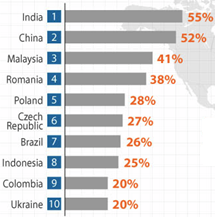Introduction to E-Learning

In this new century, internet has become an important medium in human life. Responding to the expand usage of internet as a communication medium, electronic learning (e-Learning) is an enhancement of technology that is widely used nowadays. E-Learning technology continues to become increasingly accessed and implemented by people of all aspect of life. The growing interest in e-Learning seems to be coming from several directions. These include organizations or institutions that have traditionally offered distance education programs. Many online learning courses are now available and distributed freely to be accessed via Internet for larger geographically participations scale everywhere and anytime. It is shown by the top 10 growth rates country that adopt e-Learning:
According to Horton (2012), e-Learning is the use of electronic technologies to create learning experiences that has been developed for anybody to learn anything anywhere and anytime through networking technologies. E-Learning has been formulated, organized, and created as an open-ended experience. E-Learning itself doesn’t mention any “courses” part, because courses are just used for packaging e-Learning experiences. It also has different definition with any management system.
Some people think that e-Learning is limited only for Web browser without needing other software or learning sources, but designers have created some other forms of e-Learning, such as Standalone courses, Learning games and simulations, Mobile learning, Social learning, and Virtual-classroom courses. It aims for adjusting effectiveness of e-Learning for learners (Horton, 2012).
E-Learning sometimes called online learning or an online course. E-Learning emerged as a new version of Distance Learning and it offers learning regardless of time or place once the connection to the internet is available. Using e-Learning, the interactivity and efficiency of learning increased as it gives the learners higher potential to communicate more with their instructors, other learners, and to access more the learning materials (RD.Balaji, et al., 2016).

